Abstract
In the aerospace industry, an important number of machined parts are submitted for high-performance requirements regarding surface integrity. Key components are made of materials selected for their unique properties and they are obtained by milling processes. In most situations, the milling process uses cooling methods because, in their absence, the material surface could be affected by the generated heat (temperatures could reach up to 850 °C), the residual stress, the cutting forces, and other factors that can lead to bad integrity. Cryogenic cooling has emerged as a pivotal technology in the manufacturing of aeronautical materials, offering enhanced properties and efficiency in the production process. By utilizing extremely low temperatures, typically involving liquid nitrogen or carbon dioxide, cryogenic cooling can significantly enhance the material’s properties and machining processes. Cryogenic gases are tasteless, odorless, colorless, and nontoxic, and they evaporate without affecting the workers’ health or producing residues. Thus, cryogenic cooling is also considered an environmentally friendly method. This paper presents the advantages of cryogenic cooling compared with the classic cooling systems used industrially. Improvements in terms of surface finishing, tool life, and cutting force are highlighted.
1. Introduction
The milling process is a machining method used for producing different parts of various shapes and sizes. This process is realized by removing material, in the form of chips, from a bigger part, called the workpiece. This removal is accomplished by the controlled movement of a rotary tool with multiple cutting edges, known as a cutting tool. This operation can be performed on different types of milling machines, from simple manual machines to sophisticated computer numerical control (CNC) machines [1]. The milling process is widely used across the manufacturing industry to create intricate shapes with precise dimensions in metals [2], plastics [3], and composite materials [4]. In the automotive industry, the milling process plays a crucial role in the production of engine components or chassis parts [5]. In the aerospace industry, it is used for manufacturing all kinds of parts, from the fuselage to engine components, with high precision and reliability [6], and medical equipment, like implants, prosthetics, and surgical instruments, where precision and biocompatibility are critical [7]. The electronic industry also uses the milling process for manufacturing circuit boards, connectors, and housings [8].
In most situations, the milling process uses a cooling or lubricating liquid. Without a cooling/lubricating method, various problems could arise on the surface of the material, which might be damaged by the temperature (e.g., AISI 4340—850 °C) [9]; the residual stress on the surface of the material [10]; the higher cutting forces [11,12], leading to a shorter life for the cutting tool [13]; and other factors that could lead to the bad surface integrity of the material [14,15,16,17,18,19].
The literature presents various types of lubricants or coolants that have been used to improve machinability, like oil-based fluids [20], gases and vapors [21], solid lubricants [22], and nano-cutting fluids [23]. Among these methods, cryogenic machining is a new eco-friendly technology, which uses cryogenic liquids sprayed onto the cutting zone to cool down the cutting tool and the workpiece [24]. Cryogenic liquids have boiling temperatures below −90 °C, meaning that, when sprayed onto the cutting zone, they immediately transform into gases. Most cryogenic liquids are colorless, tasteless, odorless, and nontoxic and are used in many industries, like aerospace, electronics, the automotive industry, and medical services [25,26,27,28,29,30,31].
The milling process in the aeronautical industry presents several unique complexities due to the stringent requirements for precision, material properties, and safety standards. The material selection, like a high-strength alloy, poses challenges in terms of its hardness, heat resistance, and machinability. The tolerance and surface finish must ensure optimal characteristics for the safety and reliability of the aircraft. Because of these complex factors, cryogenic cooling should be the “green” solution for optimizing the process in terms of efficiency, productivity, quality, and reducing production costs.
The aim of this review is to present the advantages of cryo-milling compared with the dry method and also the contribution of cryogenic liquids combined with the MQL method for materials used in the aerospace industry.
2. Main Materials Used in the Aeronautical Industry
The aeronautical industry utilizes a wide range of materials, each selected for its unique properties that contribute to the performance, durability, and, most importantly, the safety of the aircraft [32,33,34,35]. These materials are chosen based on their strength-to-weight ratio, corrosion resistance, thermal stability, and ease of manufacture, among other criteria. Furthermore, we describe some of the key materials [36] used in the aeronautical industry.
2.1. Aluminum Alloys
Historically, aluminum alloys have been the backbone of the aerospace industry, prized for their low weight, good corrosion resistance, and excellent mechanical properties [37]. Alloys such as 2024, 7075, and 6061 (Table 1) are commonly used in airframes and components [38]. Aluminum alloys are often encountered in structural applications in the aeronautical industry because of the exceptional balance between their strength-to-weight ratio, low density, and good maintainability at a low cost [37,39]. Over 70% of the structure and shell of an aircraft is made of aluminum alloys [34,35,40,41,42,43,44].

Table 1.
Chemical compositions of aluminum alloys mostly used in aerospace engineering.
2.2. Titanium Alloys
In the aerospace industry, titanium is preferred for its strong strength-to-weight ratio, exceptional corrosion resistance, and excellent weldability. It also has good microstructure stability and can withstand high temperatures [36]. Table 2 presents the chemical composition of the most commonly used Ti alloys found in airframes [51], turbine engines [52,53,54] (Figure 1), and structural components [55] of the aircrafts, as well as in motorsport, compressor disks, blades, and hush kits [56].

Table 2.
Chemical composition of titanium alloys.
Table 2.
Chemical composition of titanium alloys.
| C | Fe | N | Al | O | V | H | Sn | Y | Zr | Mo | Si | Nb | Other | Ti | Refs. | |
|---|---|---|---|---|---|---|---|---|---|---|---|---|---|---|---|---|
| Titanium Ti6Al4V | <0.05 | <0.3 | <0.02 | 2.5–3.5 | <0.12 | 2–3 | <0.015 | - | <0.005 | - | - | - | - | 0.4 | Bal. | [55] |
| Titanium Ti3Al2.5V | <0.05 | < 0.2 | <0.05 | 2.5–3.5 | < 0.15 | 2–3 | <0.015 | - | - | - | - | - | - | 0.35 | Bal. | [57,58] |
| Titanium Ti5Al2.5V | <0.1 | <0.5 | <0.03 | 4–6 | <0.2 | - | <0.015 | 2–3 | - | - | - | - | - | 0.35 | Bal. | [51] |
| Titanium Ti6-2-4-2S | 5.5–6.5 | <0.25 | - | - | - | - | - | 1.8–2.2 | - | 3.6–4.4 | 1.8–2.2 | 0.06–0.12 | - | - | Bal. | [59] |
| IMI 834 | - | - | - | <5.8 | - | - | - | <4 | - | <3.5 | <0.5 | <0.35 | <0.7 | - | Bal. | [60] |
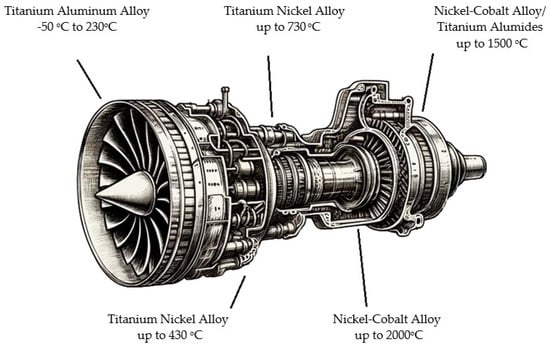
Figure 1.
Main materials and temperatures in jet engines [61,62].
2.3. Nickel-Based Superalloys
These alloys are essential for components that operate at high temperatures, such as jet engine parts (Figure 1), as well as other high-temperature alloys [63]. Nickel-based superalloys primarily consist of nickel and additional elements, including chromium, cobalt, molybdenum, aluminum, and titanium (Table 3). The specific composition varies depending on the required properties of the alloy, such as strength, corrosion resistance, and temperature stability. These materials are renowned for their excellent mechanical strength, resistance to thermal creep deformation, good surface stability, and resistance to oxidation and corrosion at high temperatures [63,64,65].

Table 3.
Chemical composition of nickel-based superalloys.
2.4. Steel Alloys
Although heavier than aluminum and titanium, certain high-strength steels are used for critical components like landing gear due to their toughness and fatigue resistance. Steel alloys used in aircrafts are often heat-treatable high-strength alloys, which may include additional elements like chromium, nickel, molybdenum, and manganese (Table 4) [70]. These elements improve the material’s mechanical properties, including tensile strength, hardness, and resistance to fatigue and corrosion [71]. Maraging steel, a low-carbon, nickel-rich variety, is known for its extreme strength and toughness without malleability loss. Common uses for steel alloys include (Figure 2) landing gears [72,73], engine components [74], actuators, and hydraulic systems [72,73].

Table 4.
Chemical composition of steel alloys.
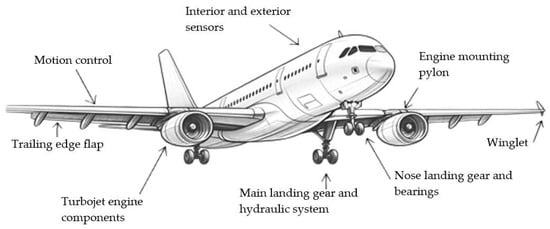
Figure 2.
Main parts that use steel alloys on Airbus and Boeing.
2.5. Other Materials Used in Aircrafts
Thermoplastics, thermoset plastics, ceramics, and ceramic matrix composites (CMCs) are used in interior cabins and nonstructural components; these materials are selected for their light weight, design flexibility, and fire resistance. Examples of thermoplastics used in aerospace include Polyetheretherketone (PEEK) and polyphenylene sulfide (PPS) [80]. Ceramic materials are used in high-temperature applications such as turbine blades and thermal protection systems, offering excellent heat resistance and strength-to-weight ratios [81]. Ceramics are employed in various aerospace applications due to their ability to withstand extreme temperatures and corrosive environments while maintaining structural integrity. The use of ceramics and ceramic matrix composites in aeronautics represents a shift towards more efficient, reliable, and sustainable air travel. Their ongoing development and integration into aerospace technologies demonstrate the industry’s commitment to innovation and performance improvement [82]. We will not further develop this section since thermoplastic and ceramic materials are not within our research scope, mainly because they are not manufactured using the milling process.
3. Cooling and Lubricating Fluids
The aerospace industry often processes hard-to-cut materials like titanium alloys (e.g., Ti-6Al-4V) [83], nickel-based superalloys (e.g., Inconel 718) [21], and high-strength aluminum alloys (e.g., 7075, 6061) [48] that require the most efficient cooling methods [84]. Depending on the process and the material, there are multiple types of coolants/lubricants available (Figure 3). The most common and efficient are emulsions [85], oil-based coolants/lubricants for the MQL method (minimum quantity lubrication) [86], and liquid nitrogen [87].
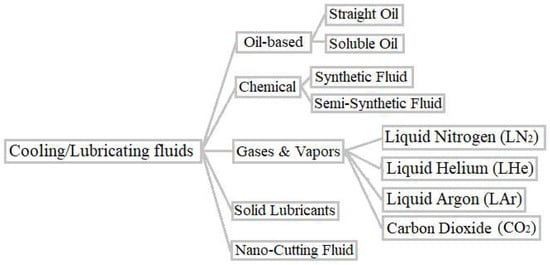
Figure 3.
Classification of main cooling/lubricating fluids.
4. Cryogenic Cooling
Cryogenic cooling refers to the process of reducing temperatures in a system or material using cryogenic fluids such as liquid nitrogen (LN2) [28], liquid helium (LHe) [88], liquid argon (LAr) [89], or liquid carbon dioxide (LCO2), which is not really considered a cryogenic liquid because of its liquefaction temperature [90]. These fluids have boiling points significantly below those of conventional cooling agents. By exploiting the extremely low temperatures of these substances, often reaching down to -196°C in the case of liquid nitrogen, cryogenic cooling can achieve effects that are not possible with traditional cooling methods. Cryogenic liquids can be applied by spraying onto the surface of the workpiece and the cutting tool or can be internally injected through channels practiced inside the cutting tool with minimal cooling impact and lower liquid consumption [24]. Cryogenic cooling is used across a wide range of applications, from industrial processes to scientific research. In manufacturing, it is employed to improve the mechanical properties of metals and alloys, enhance machining processes, and increase the durability of cutting tools. The significant decrease in temperature can cause changes in the material’s microstructure, leading to increased hardness and strength, reduced thermal expansion, and minimized wear [91] and tear during processing [92]. The use of cryogenic liquids has created new possibilities in fields such as materials science, electronics, and other areas where extreme cold is necessary to change material properties, increase efficiency, or enable new technologies [93]. Cryogenic cooling is a critical technology with wide-range implications across various sectors, offering unique solutions to challenges in manufacturing [94], electronics [95], medicine [96], and scientific research [97]. Its continued development is essential for supporting innovation and advancement in these fields [98]. Cryogenic milling, also known as cryo-milling, is a process that uses liquid nitrogen (LN2) or another cryogenic liquid such as liquid oxygen (LOX), liquid argon (LAr), liquid helium (LHe), or liquid hydrogen (LH2). The abundance of nitrogen in the atmosphere (78%) [99] makes it relatively easy to produce in liquid form. In the milling process, some materials, especially hard-to-cut materials used in the aerospace industry, such as titanium alloys (e.g., Ti-6Al-4V) [83], nickel-based superalloys (e.g., Inconel 18) [21], and high-strength aluminum alloys (e.g., 7075) [48], cannot be machined without cooling. Cryogenic cooling is recognized as an exceptionally effective method for reducing temperatures when machining these materials. LN2 is the most common cryogenic liquid; it is eco-friendly and has one of the lowest temperatures, with a boiling point of -196 °C [21]. This makes it very efficient for cooling hard-to-cut materials, resulting in good-quality manufactured parts [100].
Although cryogenic liquids take quite a long time to produce, the purpose is to discover the benefits and advantages of using cryogenic cooling in machining these hard-to-cut materials. Cryogenic cooling emerged as a pivotal technology in aeronautical materials machining, offering enhanced properties and efficiency in the production process. By using extremely low temperatures, typically involving liquid nitrogen or carbon dioxide, cryogenic cooling can have a significant impact on material properties and machining processes. Studies have found that cryogenic cooling can improve the mechanical properties of metals and alloys used in the aerospace industry. The process can increase hardness [47], wear resistance [101], and tensile strength by altering the material’s microstructure during cooling. As a result, materials become better suited for the challenging conditions of aerospace applications, such as high speeds, temperatures, and stresses [39].
4.1. Delivery Methods in Cryogenic Cooling
Two common cooling methods are used to deliver cryogenic liquids. The first method is internal injection (Figure 4), where the fluid is delivered into the cutting zone through internal channels of the cutting tool and the holder [12,24,102]. The second method is the external spray method (Figure 5), where the cryogenic fluid is sprayed directly onto the cutting zone using nozzles [83,103,104,105,106,107]. The internal injection cooling method typically uses a smaller amount of cryogenic liquid and is focused on cooling the cutting tool with less efficiency in cooling the cutting zone compared to the spray method [24].
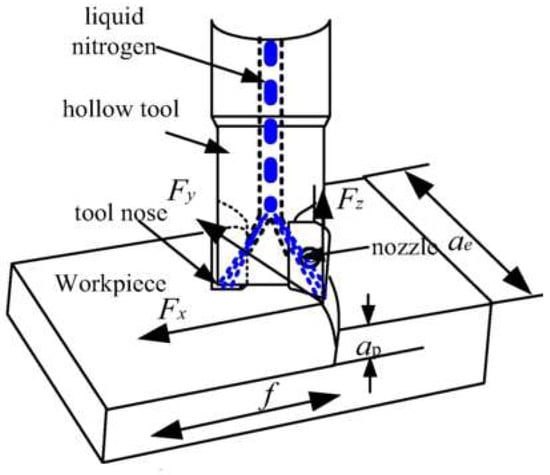
Figure 4.
Internal injection cooling method [108].
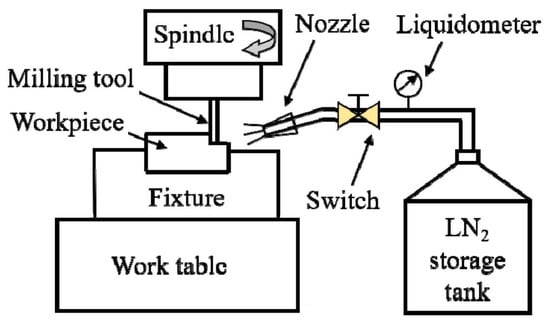
Figure 5.
Schematic diagram of cryogenic spray cooling method [103].
Considering that the best results in terms of surface quality of machined parts, tool life, and cutting forces were achieved when the MQL cooling technique was combined with the cryogenic cooling technique (see Section 4.2.), O. Pereira’s team [109] developed an innovative and easy-to-manufacture system that offers a quick solution by combining the MQL jet with four external CO2 jets (Figure 6). The innovation includes a nozzle that can mix the cryogenic liquid and the lubricating fluid, directing it to the cutting zone. The design of the system was based on the one originally patented by David P. Jackson in 2008 (Figure 7) [110].
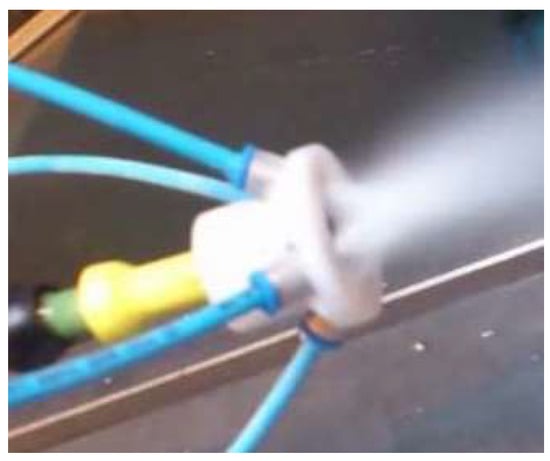
Figure 6.
CO2 adaptor mounted on the MQL nozzle [109].
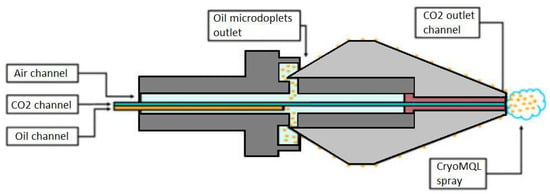
Figure 7.
Coanda effect nozzle [110].
4.2. Benefits and Features—Improved Machinability
Promising results have been reported using the combination of LN2/CO2 and MQL when machining Ti-6Al-4V in shoulder milling [111] and turning [112].
- -
- Cooling materials to cryogenic temperatures can make them more brittle, which facilitates their cutting or machining, especially for tough or elastomeric materials but also for other materials such as titanium, inconel, or aluminum. Table 5 summarizes the papers that focus on the cryo-machining of materials used in the aerospace industry included in this review. The term “machinability” can be represented by the following criteria:
- -
- Surface finish;
- -
- Tool life;
- -
- Cutting force;
- -
- Chip shape;
- -
- Limiting rate of removed material [113].

Table 5.
Summary of the papers focusing on the cryo-machining of materials used in the aerospace industry.
Table 5.
Summary of the papers focusing on the cryo-machining of materials used in the aerospace industry.
| Reference | Workpiece Material | Machining Outputs | Cooling Method | Obs. |
|---|---|---|---|---|
| [84] | Al 6082 | Flank wear Crater wear Surface roughness Topography and texture of the machined surface | Dry machining MQL LCO2 MQL + LCO2 | |
| [102] | Al 6082-T6 | Cutting temperature Surface roughness Cutting forces Surface morphology Chip morphology Tool wear | LCO2 LN2 conventional wet machining | |
| [106] | Al 8011 | Cutting temperature Surface roughness Tool wear Chip morphology Microstructure analysis Hardness | Dry machining conventional wet machining LCO2 MQL MQL + LCO2 | |
| [114] | Al 7075 | Surface roughness Cutting temperature Cutting force | LN2 conventional wet machining | turning |
| [115] | Al 7075 | Cutting force Surface roughness Chip morphology Tool wear Surface roughness | Dry machining LCO2 MQL MQL + LCO2 | |
| [12] | Ti-6Al-4V | Cutting force | Dry machining LN2 | |
| [24] | Ti-6Al-4V | Cutting force Tool wear Tool performance | conventional wet machining nano-MQL LN2 (internal and external) nano-MQL + LN2 | |
| [83] | Ti-6Al-4V | Workpiece temperature Resulting forces Microhardness of the workpiece surface Surface topography | Dry machining LCO2 Sub-zero MWF | |
| [104] | Ti-6Al-4V | Cutting temperature Surface roughness Chip morphology Cutting forces Tool wear Microhardness | Conventional wet machining LCO2 MQL + LN2 | |
| [116] | Ti-6Al-4V | Surface roughness Tool wear Power consumption | Dry machining conventional wet machining cryogenic machining | |
| [117] | Ti-3Al-2.5V | Power consumption | Dry machining MQL LN2 MQL + LN2 | |
| [11] | Inconel 718 | Tool wear Cutting forces | MQL Conventional wet machining MQL + LCO2 | |
| [13] | Inconel 625 | Surface roughness Tool wear Cutting temperature Chip morphology | MQL LN2 MQL + LN2 | |
| [21] | Inconel 718 | Cutting force Tool wear | Conventional wet machining LCO2 (internal and external) MQL MQL + LCO2 | |
| [66] | Inconel 718 | Tool wear Surface roughness | Dry machining LCO2 | |
| [105] | Inconel 718 | Tool wear Energy consumption Chip reduction coefficient Surface roughness | Dry machining conventional wet machining LN2 | turning |
| [118] | Inconel 718 | Surface roughness Residual stress Chip morphology Cutting force Tool wear | Dry machining High pressure jet LN2 MQL Nano-MQL | turning |
| [119] | Inconel 718 | Surface roughness Tool wear Microhardness | Conventional wet machining MQL + LN2 | turning |
| [120] | Inconel 718 | Tool wear Surface roughness Chip morphology | Dry machining Conventional wet machining LCO2 MQL + LCO2 | turning |
| [121] | Inconel 718 | Tool wear Cutting forces Tool temperature | LCO2 internal and external | |
| [107] | AISI-4037 | Surface roughness Cutting temperature Dimensional deviation Pattern and chip formation mode Cutting force | Dry machining Conventional wet machining LN2 | turning |
| [122] | AISI 4340 | Surface roughness Cutting temperature | Dry machining LN2 | |
| [91] | AISI 4041 | Tool wear Cutting temperature | Dry machining LN2 LCO2 MQL MQL + LCO2 | turning |
| [103] | SiCp/Al composites | Cutting forces Chip morphology Surface topography | Dry machining LN2 |
4.2.1. Surface Finish
The surface finish is represented by the roughness and the cleanliness of the machined surface. This is mostly affected by the feed rate and the cutting speed [123], but the adhesion of the material to the cutting tool also has a significant impact [39]. In a study on the surface finish of AISI 4340, machining tests were conducted at a depth of cut ap = 0.3 mm with two different cutting speeds, Vc = 180 and 220 m/min, and two feeds, fz = 0.10 and 0.15 mm/tooth, under both dry and cryogenic conditions [122]. In these experiments, only the surface roughness, Ra, was measured after the tests, and the best results were obtained for processing the material under LN2 cooling. Under dry conditions, at a cutting speed Vc = 180 m/min, the roughness was Ra = 0.33 µm, while, under LN2 cooling, the roughness was improved by approximately 25%, resulting in a value of 0.25 µm. For Vc = 220 m/min, the improvement was reduced to only 14%, from Ra = 0.35 µm under dry condition to Ra = 0.3 µm under LN2 cryogenic spray [122] (Figure 8). The results revealed that the feed rate had the most important influence on the surface roughness, with the depth of cut having a much smaller impact.
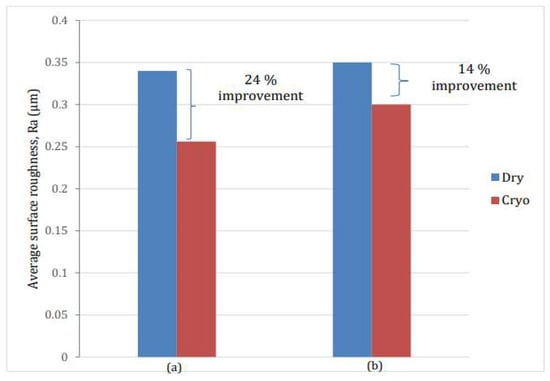
Figure 8.
Average surface roughness in dry and cryogenic milling of AISI 4340 at (a) Vc: 180 m/min, fz: 0.1 mm/tooth, ap: 0.3 mm; (b) Vc: 220 m/min, fz: 0.15 mm/tooth, ap: 0.3 mm [122].
These results were confirmed by the tests made on AISI 4037 by Dhar and Kamruzzaman, who compared cryogenic machining to wet and dry cooling procedures. Even though the process involved turning and not milling, the surface roughness (Ra) for cryogenic cooling was smaller than for dry turning conditions, with Ra = 3 µm and Ra = 4 µm, respectively, which represented a 25% improvement (Figure 9) [107].
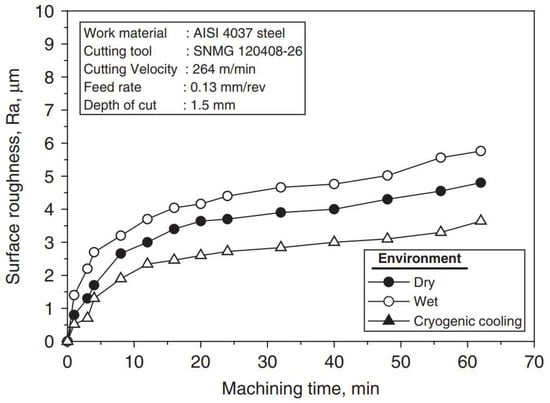
Figure 9.
Surface roughness developed with machining time under different environments at Vc = 264 m/min [107].
Good improvement in the surface finish was also observed when milling aluminum alloys under the cryogenic cooling method. Using a cutting speed of 5000 rpm, feed rates of 90 and 150 mm/min, and a depth of cut of 3 mm on 6061-T6 aluminum, cryo-milling and dry machining resulted in an improvement of almost 50% between the two methods. Surface roughness Ra = 1.8/1.9 µm was measured for dry and flooded milling, while, for cryogenic milling, roughness was Ra = 1.1 µm, all for 90 mm/min feed rate. For the 150 mm/min feed rate, the values were almost the same, with Ra = 1.6/1.8 µm for dry milling and Ra = 0.9 µm for cryogenic milling [39] (Figure 10).
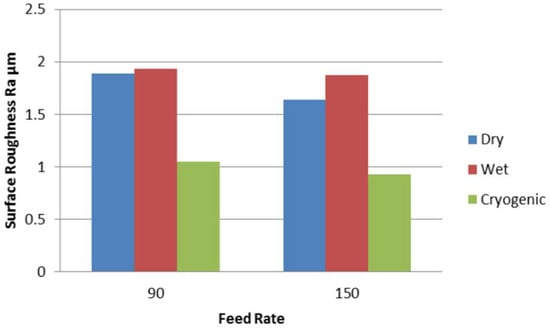
Figure 10.
Surface roughness: dry vs. wet vs. cryo [39].
Similar findings were reported by V. Sivalingam et al. [84] for the milling of aluminum alloy 6082, which focused on surface morphology. Two sets of parameters were used to machine the alloy: vc = 90 m/min, f = 0.1 mm/rev and vc = 120 m/min, f = 0.2 mm/rev under dry, MQL, cryogenic, and MQL + cryogenic conditions. The results after machining the alloy revealed that, for the first set of parameters, the surface roughness improved from Ra = 1.9 µm for the dry milling to Ra = 0.62 µm for the cryogenic milling, resulting in an improvement over 200%. When increasing the Vc while maintaining the same feed, the difference was smaller but still significant (158%), with variation from 1.65 µm for dry milling to 0.58 µm for cryogenic milling. Increasing the feed rate to f = 0.2 mm/rev resulted in similar results. For those parameters, cryogenic milling also yielded better results in terms of surface roughness compared to MQL (53% lower). Only in the case of the combined MQL and cryo-cooling, a small improvement in roughness (only 20%) was obtained compared to cryo-cooling [84] (Figure 11).
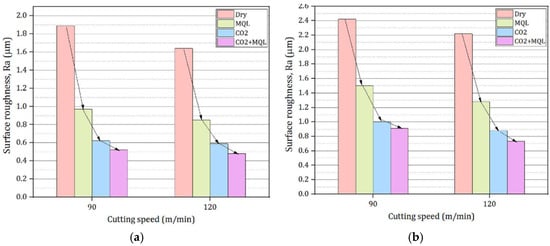
Figure 11.
Surface roughness: dry vs. MQL vs. cryo vs. cryo + MQL: (a) f = 0.1 mm/rev; (b) f = 0.2 mm/rev [84].
Cryogenic milling of aluminum alloys offers an important advantage by reducing the adhesion of the chips to the cutting tool and improving the cleanliness of the surface. The reduced temperature creates a hardening effect on the chips and prevents the chemical reactions between the aluminum and the cutting tool [39], thus reducing the adhesion phenomena. Lower adhesion reduces chip–tool friction, resulting in a decrease in the cutting temperatures and cutting forces, which are tightly connected to the residual stress on the workpiece surface. N. H. A. Halim et al. [66] also found that using LN2 while milling resulted in achieving a better surface roughness in the case of Inconel 718 machining. In their experiments, cryogenic cooling was compared to dry milling of this hard-to-cut material, using PVD multi-coated carbide milling inserts. Table 6 presents the values of the controlled parameters.

Table 6.
Cutting parameters [66].
The results showed an improvement of roughness (Ra) by 75% and 142.8% compared to dry milling, proving that the cryogenic milling managed to extend the tool life (Figure 12)
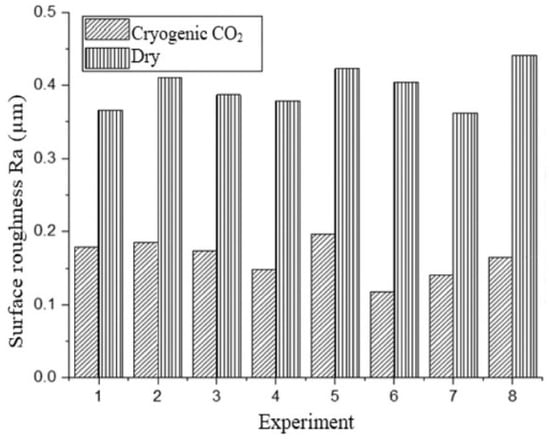
Figure 12.
Surface roughness: dry vs. cryo for all 8 parameters [66].
Overall, we can state that the cryogenic milling approach offers important benefits regarding the surface finish, improving the surface roughness, with percentages varying from 14 to 158% depending on the machining parameters and the working material. These findings might be explained by the fact that the machining temperature was significantly reduced by the presence of the cryogenic agent and also the lubricating effect being induced in the case of MQL and cryoMQL leading to a lower adhesion of the material to the cutting tool and lower friction between the two.
4.2.2. Tool Life
Cooling and lubricating the work tool leads to an increased tool life [24,124]. However, liquid nitrogen, a gas-based coolant, is not known for its lubricating properties. Nevertheless, under certain conditions, it can improve the tool life when milling specific materials.
Research conducted by V. Sivalingam et al. [84] showed that cryo-milling of aluminum alloy 6082 leads to improved tool life compared to dry milling. Tests performed with two cutting speeds (90m/min and 120 m/min) over a length of cut of 350 mm revealed significant improvements in flank wear (46% and 55%) compared to the dry milling (Figure 13).
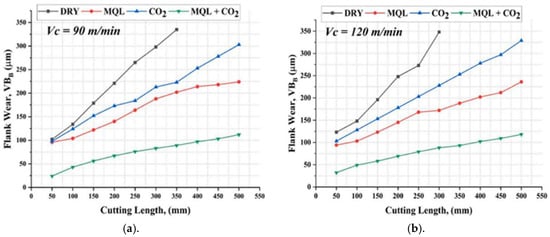
Figure 13.
Tool flank wear for a. f = 0.1 mm/rev and b. f = 0.2 mm/rev: (a) f = 0.1 mm/rev; (b) f = 0.2 mm/rev [84].
In a study by M. A. Suhaimi et al. [24], the milling of grade 5 titanium alloy, Ti-6Al-4V, under the influence of liquid nitrogen compared to flood coolant and MQL was presented. The study found that the flank wear of the cutting tool was smaller when milling with cryogenic cooling compared to dry milling but larger compared to MQL milling. The improvement from using cryogenic cooling compared to flood coolant milling was about 5%, which was not considered significant. However, combining MQL with liquid nitrogen spray showed a substantial improvement of 90% compared to flood cooling [24]. It was also noted that the spray method of LN2 was more efficient compared to internal injection (Figure 14).
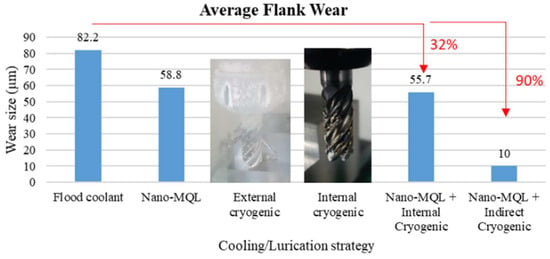
Figure 14.
Average flank wear for all 6 cooling methods [24].
Another research study conducted by A. Shokrani et al. [116] on the same titanium alloy (Ti-6Al-4V) focused on the tool wear and surface quality. The experiment used a cutting speed (Vc) of 70 m/min, a feed rate (fz) of 0.03mm/tooth, a depth of cut (ap) of 1 mm, and an immersion rate of 50%. The study compared the effects of cryogenic cooling and dry milling. The results showed that cryogenic cooling improved the tool life compared to the other two methods. The flank wear for the cryo-milling was VB = 0.065 mm compared to 0.15 mm and 0.17 mm for dry and wet milling, respectively. Using LN2 improved the tool life with 130% compared to dry milling [116] (Figure 15).

Figure 15.
Approximate time until the PVD coating wears off [116].
An improvement of the tool life was also observed while milling Inconel 718 under the influence of the cryogenic liquid. Depending on the milling parameters, improvements between 20 and 90% have been highlighted [66]. All the cutting parameters used by Halim et al. are presented in Table 6.
Tests made on nickel-based superalloy, Inconel 625, showed that lubrication is required during machining to decrease tool wear [13]. For a cutting depth of 0.5 mm and a feed rate of 0.12 mm/rev, three cutting speeds (50, 75, and 100 m/min) were tested. As expected, the higher the cutting speed, the higher the tool wear, with 25% more wear for the cryogenic cooling compared to the MQL. Thus, the simple cryogenic cooling was not adequate to increase tool life but improvement was obtained when it was combined with MQL. However, combined cryogenic cooling and MQL led to a 333% improvement in tool life compared to using only MQL [13] (Figure 16). Similar results were reported by O. Pereira [11] for Inconel 718, demonstrating that cryoMQL can be a reliable alternative to wet machining.
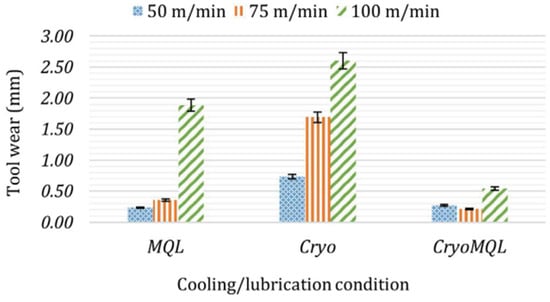
Figure 16.
Average flank wear for all 3 parameters [13].
4.2.3. Cutting Force and Surface Stress
Overall, the flank wear was reduced by 4 to 333% when cryogenic cooling was involved compared to dry milling due to the reduction in the thermal effect and the mechanical stress.
In most experiments, cutting forces are closely linked to tool wear. The force needed to machine the workpiece increases significantly once the insert flank starts to wear [24]. Flood cooling and nano-MQL produced similar cutting force values, whereas catastrophic failure occurred when machining Ti-6Al-4V with either internal or external cryocooling due to the lack of lubrication. Nevertheless, the best results in terms of cutting forces were achieved when nano-MQL was combined with indirect cryogenic cooling (Figure 17).
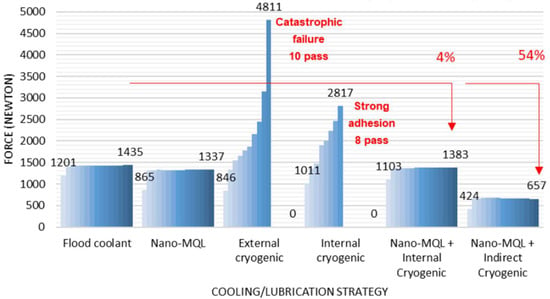
Figure 17.
Cutting force for all cooling/lubrications methods [24].
Cutting forces were also measured in the articles of O. Pereira et al. [21,121]. In [20], the cutting force while milling Inconel 718 was compared among wet, cryogenic, MQL, and cryoMQL machining. The experiments showed that wet machining with oil emulsion (10% synthetic oil) yielded the best results compared to the other cooling/lubricating methods. Nevertheless, the increase in the cutting forces is not quite significant when using cryoMQL or internal and external CO2 cryogenic cooling (Figure 18). Considering that chemical-based cooling fluids raise important risks for human health and the environment [125], it can be concluded that cryocooling could represent a viable option for Inconel 718 machining.
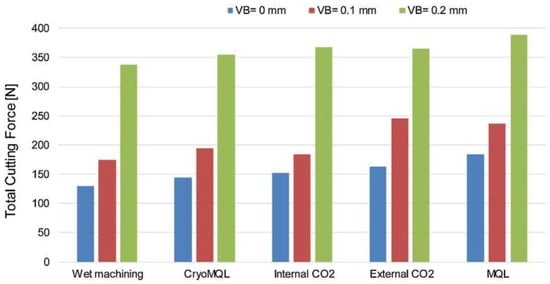
Figure 18.
Cutting force for all cooling/lubrication methods [21].
Yuan Ma et al. [126] have developed a new prediction model of residual stress based on three directional cutting forces and cutting temperatures under different feed rates and depth of cuts. They concluded that the cutting forces, temperature, and the value of tensile surface residual stress increased with the increase in feed rate and depth of cut. In end milling, the thermal effect leads to tensile residual stress, while the mechanical effect, represented by the cutting forces, results in compressive residual stress along peripheral direction. G. Li et al. [127] proposed a prediction method for residual stress in the turning of Ti-6Al-4V. They determined that three parameters have the greatest influence on residual stress: friction coefficient, tool edge radius, and cutting speed. The friction coefficient and tool edge radius affect the thickness of the residual stress layer, while the increase in the cutting speed determines the transformation of residual stress to tensile stress. The residual stress prediction model, based on cutting force and cutting temperature, produced good results, with errors lower than 6%. Jiang et al. [128] built a model to quantitatively analyze the influence of cutting force and temperature on residual stress generation. The model showed that the cutting force played a leading role compared to the influence of temperature. The tangential residual stress is mainly caused by tangential force and temperature, while radial residual stress is mainly influenced by the radial force, with temperature having a smaller influence than its effects on the tangential residual stress. The article by X. Zang et al. demonstrated a direct proportionality between cutting force and residual stress [10]. They found that machining the aluminum–lithium alloy under the influence of LN2 cooling improved structural fatigue. The test results showed that the aluminum–lithium alloy part suffered compression stress on the surface. All the values were negative but, under the LN2 influence, the values showed 100 MPa difference in favor of the cryogenic liquid (Figure 19) [10].

Figure 19.
Cutting forces under cryo conditions (Case 1–4) and under dry conditions (Case 5–8) [10].
Dhananchezian and Kumar [129] prepared modified multi-coated carbide tools for the turning process of steel (AISI 1045). They observed that cryogenic cooling reduced cutting force by 27% and surface roughness by over 25% compared to wet machining. Kaynak et al. [130] and Deshpande et al. [131] used cryogenically treated and untreated tools in machining Inconel 718—a nickel-based alloy. They reported that the metallurgy of the tool material along with the mechanical and thermal properties are highly improved by cryogenic treatment of the tool. The treated tool improved product quality, tool life, and material removal rate, while also reducing cutting temperature, cutting forces, and tool vibration.
5. Conclusions
Cryogenic cooling in machining gained popularity in the early 2000s, and the number of published papers on this matter has constantly increased ever since. In this context, the present review was intended as a summary of the most important advantages of cryocooling over the other available cooling methods for the processing of materials used in the aerospace industry.
The most efficient cryogenic cooling method is spraying, as it cools down the cutting tool and the cutting zone but, most importantly, it cools down the workpiece before and after it is manufactured. The area of cryogenic spray is usually larger compared to the internal cooling method, similar to the flooding method or the MQL method. In most cases, cryogenic cooling, either alone or combined with MQL, increases tool life and reduces cutting forces compared to dry machining. It also results in better surface quality and allows machining at a lower temperature. Reduction in cutting force is associated with lower power consumption, making cryocooling an eco-friendly cooling method. Additionally, cryogenic liquids are eco-friendly because they are colorless, tasteless, odorless, and nontoxic, and they evaporate without leaving any residue. Therefore, we can state that cryo-milling is, in fact, “green manufacturing”. Increasing tool life is very important as it allows more parts to be manufactured with the same cutting tool before it needs to be replaced, contributing to reducing the manufacturing costs.
Author Contributions
B.N.: conceptualization and writing—original draft preparation; R.I.T.: conceptualization, resources, and writing—review and editing; B.A.C.: review and editing; C.T., E.H. and C.S.: supervision. All authors have read and agreed to the published version of the manuscript.
Funding
This research received no external funding.
Data Availability Statement
No new data were created or analyzed in this study. Data sharing is not applicable to this article.
Conflicts of Interest
The authors declare no conflicts of interest.
References
- Ackroyd, B.; Akcan, N.; Chhabra, P.; Krishnamurthy, K.; Madhavan, V.; Chandrasekar, S.; Compton, W.; Farris, T. Exploration of contact conditions in machining. Proc. Inst. Mech. Eng. Part B J. Eng. Manuf. 2001, 215, 493–507. [Google Scholar] [CrossRef]
- Kursun, C.; Gao, M.; Yalcin, A.O.; Parrey, K.A.; Gaylan, Y. Structure, mechanical, and neutron radiation shielding characteristics of mechanically milled nanostructured (100-x)Al-xGd2O3 metal composites. Ceram. Int. 2024, 50, 27154–27164. [Google Scholar] [CrossRef]
- Schmidt, J.; Thorenz, B.; Döpper, F. Design of a reference part for the comparison of tools in plastic milling operations. Procedia CIRP 2023, 119, 981–986. [Google Scholar] [CrossRef]
- Jayakumar, K. Optimization of cutting force and surface roughness in end milling of AA-TiCp composite. Mater. Today Proc. 2024. [Google Scholar] [CrossRef]
- Elmaraghy, W.; Elmaraghy, H.; Tomiyama, T.; Monostori, L. Complexity in engineering design and manufacturing. CIRP Ann. Manuf. Technol. 2012, 61, 793–814. [Google Scholar] [CrossRef]
- Saha, P.K. Aerospace Manufacturing Processes. Aeronaut. J. 2017, 121, 21–22. [Google Scholar] [CrossRef]
- Groover, M.P. Fundamentals of Modern Manufacturing: Materials, Processes, and Systems, 7th ed.; Wiley: Hoboken, NJ, USA, 2019. [Google Scholar]
- Lau, J.H.; Wong, C.P.; Prince, J.L. Electronic Packaging: Design, Materials, Process, and Reliability; McGraw-Hill: New York, NY, USA, 1998. [Google Scholar]
- Sheik Muhamad, S.; Ghani, J.; Haron, C.; Yazid, H. Cryogenic milling and formation of nanostructured machined surface of AISI 4340. Nanotechnol. Rev. 2020, 9, 1104–1117. [Google Scholar] [CrossRef]
- Zhang, X.; Mu, H.; Huang, X.; Fu, Z.; Zhu, D.; Ding, H. Cryogenic Milling of Aluminium-lithium Alloys: Thermo-mechanical Modelling towards Fine-tuning of Part Surface Residual Stress. Procedia CIRP 2015, 31, 160–165. [Google Scholar] [CrossRef]
- Pereira, O.; Urbikain, G.; Rodríguez, A.; Fernández-Valdivielso, A.; Calleja, A.; Ayesta, I.; de Lacalle, L.N.L. Internal cryolubrication approach for Inconel 718 milling. Procedia Manuf. 2017, 13, 89–93. [Google Scholar] [CrossRef]
- Elefanti, A.; Albertelli, P.; Strano, M.; Monno, M. Estimation of cutting and friction coefficients in dry and cryogenic milling through experiments and simulations. In AIP Conference Proceedings; AIP Publishing: Woodbury, NY, USA, 2019; Volume 2113. [Google Scholar] [CrossRef]
- Yıldırım, Ç.V.; Kıvak, T.; Sarıkaya, M.; Şirin, Ş. Evaluation of tool wear, surface roughness/topography and chip morphology when machining of Ni-based alloy 625 under MQL, cryogenic cooling and CryoMQL. JMR&T 2020, 9, 2079–2092. [Google Scholar] [CrossRef]
- Hardada, Y.; Hattori, S. Deep drawability of Ti/resin/Ti laminated sheet. In Proceedings of the International Conference of Global Network for Innovative Technology and Awam International Conference in Civil Engineering (IGNITE-AICCE’17): Sustainable Technology And Practice For Infrastructure and Community Resilience, Dublin, Ireland, 16 October 2017; Volume 1896, p. 080005. [Google Scholar]
- Sharma, V.S.; Dogra, M.; Suri, N.M. Cooling techniques for improved productivity in turning. Int. J. Mach. Tool. Manu. 2009, 49, 435–453. [Google Scholar] [CrossRef]
- Cassin, C.; Boothroyd, G. Lubricating action of cutting fluids. J. Mech. Eng. Sci. 1965, 7, 67–81. [Google Scholar] [CrossRef]
- Mazurkiewicz, M.; Kubala, Z.; Chow, J. Metal machining with high-pressure water-jet cooling assistance—A new possibility. J. Eng. Ind. 1989, 111, 7–12. [Google Scholar] [CrossRef]
- Pan, Z.; Yao, B.; Chen, B.; Huang, J.; Ma, X.; Lan, Q. Cutting force model of milling titanium alloy with C60 nanofluid minimum quantity lubrication. J. Man. Proc. 2023, 105, 295–306. [Google Scholar] [CrossRef]
- Sadeghifar, M.; Javidikia, M.; Loucif, A.; Jahazi, M.; Songmene, V. Experimental and numerical analyses of residual stress redistributions in large steel dies: Influence of tempering cycles and rough milling. J. Mater. Res. Technol. 2023, 24, 395–406. [Google Scholar] [CrossRef]
- Mohd Asmadi, N.A.N.; Zee, K.M.; Baskaran, S.M.; Ariffin, H.; Wasoh, H.; Maeda, T.; Hassan, M.A.; Zakaria, M.R. Rhamnolipids production by Pseudomonas aeruginosa RW9 using palm oil mill effluent sludge oil as a carbon source. Biocatal. Agric. Biotechnol. 2024, 57, 103069. [Google Scholar] [CrossRef]
- Pereira, O.; Celaya, A.; Urbikaín, G.; Rodríguez, A.; Fernández-Valdivielso, A.; De Lacalle, L.N.L.d. CO2 cryogenic milling of Inconel 718: Cutting forces and tool wear. J. Mater. Res. Technol. 2020, 9, 8459–8468. [Google Scholar] [CrossRef]
- Rao, S.; Sandeep, M.; Kumaraswami, R.; Shravan, A. A critical review on solid lubricants. IJMET 2016, 7, 193–199. [Google Scholar]
- Boopathi, S.; Elangovan, M.; Meka, U. Applications of Nano-Cutting Fluids in Advanced Machining in Processes. In Production, Properties, and Applications of Engineered Cementitious Composites; IGI Global: Hershey, PA, USA, 2023; pp. 211–234. [Google Scholar]
- Suhaimi, M.A.; Yang, G.-D.; Park, K.-H.; Hisam, M.J.; Sharif, S.; Kim, D.-W. Effect of Cryogenic Machining for Titanium Alloy Based on Indirect, Internal and External Spray System. Procedia Manuf. 2018, 17, 158–165. [Google Scholar] [CrossRef]
- Yildiz, Y.; Nalbant, M. A review of cryogenic cooling in machining processes. Int. J. Mach. Tool Manu. 2008, 48, 947–964. [Google Scholar] [CrossRef]
- Zheng Yang, K.; Pramanik, A.; Basak, A.K.; Dong, Y.; Prakash, C.; Shankar, S.; Dixit, S.; Kumar, K.; Ivanovich Vatin, N. Application of coolants during tool-based machining–A review. Ain Shams Eng. J. 2023, 14, 101830. [Google Scholar] [CrossRef]
- Kumar Gupta, M.; Korkmaz, M.E.; Sarıkaya, M.; Krolczyk, G.M.; Günay, M. In-process detection of cutting forces and cutting temperature signals in cryogenic assisted turning of titanium alloys: An analytical approach and experimental study. Mech. Syst. Signal Process. 2022, 169, 108772. [Google Scholar] [CrossRef]
- Khanna, N.; Wadhwa, J.; Pitroda, A.; Shah, P.; Schoop, J.; Sarıkaya, M. Life cycle assessment of environmentally friendly initiatives for sustainable machining: A short review of current knowledge and a case study. Sustain. Mater. Techno. 2022, 32, e00413. [Google Scholar] [CrossRef]
- Gupta, M.K.; Korkmaz, M.E.; Sarıkaya, M.; Krolczyk, G.M.; Günay, M.; Wojciechowski, S. Cutting forces and temperature measurements in cryogenic assisted turning of AA2024-T351 alloy: An experimentally validated simulation approach. Measurement 2022, 188, 110594. [Google Scholar] [CrossRef]
- Dixit, S.; Singh, P. Investigating the disposal of E-Waste as in architectural engineering and construction industry. Mater Today Proc. 2022, 56, 1891–1895. [Google Scholar] [CrossRef]
- Dixit, S.; Stefańska, A.; Musiuk, A.; Singh, P. Study of enabling factors affecting the adoption of ICT in the Indian built environment sector. Ain. Shams. Eng. J. 2021, 12, 2313–2319. [Google Scholar] [CrossRef]
- Jayakrishna, K.; Kar, V.R.; Sultan, M.T.H.; Rajesh, M. 1-Materials selection for aerospace components. In Sustainable Composites for Aerospace Applications; Jawaid, M., Thariq, M., Eds.; Woodhead Publishing: Sawston, UK, 2018; pp. 1–18. [Google Scholar]
- Aamir, M.; Giasin, K.; Tolouei-Rad, M.; Vafadar, A. A review: Drilling performance and hole quality of aluminium alloys for aerospace applications. J. Mater. Res. Technol. 2020, 9, 12484–12500. [Google Scholar] [CrossRef]
- Dursun, T.; Soutis, C. Recent developments in advanced aircraft aluminium alloys. Mater. Des. 2014, 56, 862–871. [Google Scholar] [CrossRef]
- Starke, E.A.; Staley, J.T. Application of modern aluminum alloys to aircraft. Prog. Aerosp. Sci. 1996, 32, 131–172. [Google Scholar] [CrossRef]
- Boyer, R.R.; Briggs, R.D. The use of β titanium alloys in the aerospace industry. J. Mater. Eng. Perform. 2005, 14, 681–685. [Google Scholar] [CrossRef]
- Li, S.S.; Yue, X.; Li, Q.Y.; Peng, H.L.; Dong, B.X.; Liu, T.S.; Yang, H.Y.; Fan, J.; Shu, S.L.; Qiu, F.; et al. Development and applications of aluminum alloys for aerospace industry. J. Mater. Res. Technol. 2023, 27, 944–983. [Google Scholar] [CrossRef]
- Aluminum and Aluminum Alloys. Metals Handbook Desk Edition, 2nd ed.; Davis, J.R., Ed.; ASM International: Almere, The Netherlands, 1998; pp. 417–423. [Google Scholar]
- Dhokia, V.; Chaharsooghi, A.S.; Paulino, D.C.; Newman, S.T. Effect of Cryogenic Cooling on the Surface Quality and Tool Wear in End Milling 6061-T6 Aluminium. In Proceedings of the Paper presented at 22nd International Conference on Flexible Automation and Intelligent Manufacturing (FAIM 2012), Helsinki, Finland, 10–13 June 2012. [Google Scholar]
- Heinz, A.; Haszler, A.; Keidel, C.; Moldenhauer, S.; Benedictus, R.; Miller, W.S. Recent development in aluminium alloys for aerospace applications. Mater. Sci. Eng. A 2000, 280, 102–107. [Google Scholar] [CrossRef]
- Sun, R.; Li, L.; Zhu, Y.; Guo, W.; Peng, P.; Cong, B.; Sun, J.; Che, Z.; Li, B.; Guo, C.; et al. Microstructure, residual stress and tensile properties control of wire-arc additive manufactured 2319 aluminum alloy with laser shock peening. J. Alloys Compd. 2018, 747, 255–265. [Google Scholar] [CrossRef]
- Gordon, J.V.; Haden, C.V.; Nied, H.F.; Vinci, R.P.; Harlow, D.G. Fatigue crack growth anisotropy, texture and residual stress in austenitic steel made by wire and arc additive manufacturing. Mater. Sci. Eng. A 2018, 724, 431–438. [Google Scholar] [CrossRef]
- Li, Q.; Wu, A.; Li, Y.; Wang, G.; Yan, D.; Liu, J. Influence of temperature cycles on the microstructures and mechanical properties of the partially melted zone in the fusion welded joints of 2219 aluminum alloy. Mater. Sci. Eng. A 2015, 623, 38–48. [Google Scholar] [CrossRef]
- Wang, G.; Zhao, Y.; Hao, Y. Friction stir welding of high-strength aerospace aluminum alloy and application in rocket tank manufacturing. J. Mater. Sci. Technol. 2018, 34, 73–91. [Google Scholar] [CrossRef]
- Araghchi, M.; Mansouri, H.; Vafaei, R.; Guo, Y. A novel cryogenic treatment for reduction of residual stresses in 2024 aluminum alloy. Mater. Sci. Eng. A 2017, 689, 48–52. [Google Scholar] [CrossRef]
- Bektaş, B.S.; Samtaş, G. Optimisation of cutting parameters in face milling of cryogenic treated 6061 aluminium alloy and effects on surface roughness, wear, and cutting temperatures. Surf. Topogr. Metrol. Prop. 2022, 10, 025013. [Google Scholar] [CrossRef]
- Tampu, C.; Chirita, B.; Cristea, I.; Zichil, V.; Schnakovszky, C.; Herghelegiu, E.; Carausu, C. Influence of cutting parameters on surface hardness in milling of AL6061T6. IOP Conf. Ser. Mater. Sci. Eng. 2020, 916, 012118. [Google Scholar] [CrossRef]
- Zhang, P.; Liu, Z.; Liu, J.; Yu, J.; Mai, Q.; Yue, X. Effect of aging plus cryogenic treatment on the machinability of 7075 aluminum alloy. Vacuum 2023, 208, 111692. [Google Scholar] [CrossRef]
- AZO Materials. Aluminum 7150 Alloy (UNS A97150). Available online: https://www.azom.com/article.aspx?ArticleID=8766 (accessed on 14 May 2024).
- MatWeb Material Property Data. Aluminum 7155 Composition Spec. Available online: https://www.matweb.com/search/datasheet.aspx?matguid=173f047427fe4b25a632f8ca59e7f35c&ckck=1 (accessed on 19 May 2024).
- Alloys International INC. Titanium 5-2.5 5Al-2.5Sn (Grade 6). Available online: https://alloysintl.com/titanium-alloys-supplier/titanium_5-2-5/ (accessed on 3 January 2024).
- Williams, J.C.; Boyer, R.R. Opportunities and Issues in the Application of Titanium Alloys for Aerospace Components. Metals 2020, 10, 705. [Google Scholar] [CrossRef]
- Donachie, M.J. Titanium: A Technical Guide; ASM International: Almere, The Netherlands, 2000. [Google Scholar]
- Welsch, G.; Boyer, R.; Collings, E. Materials Properties Handbook: Titanium Alloys; ASM International: Almere, The Netherlands, 1993. [Google Scholar]
- Lütjering, G.; Williams, J.C. Introduction. In Titanium; Lütjering, G., Williams, J.C., Eds.; Springer: Berlin/Heidelberg, Germany, 2003; pp. 1–11. [Google Scholar]
- NeoNickel. Titanium 6-2-4-2. Available online: https://www.neonickel.com/alloys/titanium-alloys/ti-6-2-4-2/ (accessed on 13 March 2024).
- Aircraft Materials. Titanium Alloy Grade 9/Ti-3Al-2.5V. Available online: https://www.aircraftmaterials.com/data/titanium/ti3al2-5v.html (accessed on 9 February 2024).
- AZO Materials. Grade 9 Ti 3Al 2.5V Alloy (UNS R56320). Available online: https://www.azom.com/article.aspx?ArticleID=9337 (accessed on 22 April 2024).
- Data, M.M.P. Titanium Ti-6Al-2Sn-4Zr-2Mo (Ti-6-2-4-2). Available online: https://www.matweb.com/search/datasheet.aspx?matguid=3a01802b122647028633c9fa10e6bae8 (accessed on 19 November 2023).
- MatWeb Material Property Data. Titanium IMI 834. Available online: https://www.matweb.com/search/DataSheet.aspx?MatGUID=a74096c99aa6486382a9c9e1be0883c4&ckck=1 (accessed on 13 March 2024).
- Saraçyakupoğlu, T. The novel manufacturing techniques of the airborne parts. In Theory and Research in Engineering II, 1st ed.; Kalkanci, M., Ed.; Gece Publishing: Kezlema, Turkey, 2020; pp. 179–194. [Google Scholar]
- Al-Nafeay, R.H.; Al-Roubaiy, A.O.; Omidvar, H. Overview of Joining and Repairing Techniques of Ni-Based Superalloy for Industrial Gas Turbine Applications. IOP Conf. Ser. Mater. Sci. Eng. 2021, 1094, 012141. [Google Scholar] [CrossRef]
- Donachie, M.J.; Donachie, S.J. Superalloys: A Technical Guide, 2nd ed.; ASM International: Almere, The Netherlands, 2002. [Google Scholar] [CrossRef]
- Reed, R.C. The Superalloys Fundamentals and Applications; Cambridge University Press: Cambridge, UK, 2006. [Google Scholar] [CrossRef]
- Singh, S. Superalloys Report. 2016. Available online: https://www.researchgate.net/publication/291336421_Superalloys_Report?channel=doi&linkId=56a06eb608aee4d26ad4107b&showFulltext=true#fullTextFileContent (accessed on 19 April 2024). [CrossRef]
- Halim, N.H.A.; Haron, C.H.C.; Ghani, J.A. PVD multi-coated carbide milling inserts performance: Comparison between cryogenic and dry cutting conditions. J. Manuf. Process. 2022, 73, 895–902. [Google Scholar] [CrossRef]
- Bhadeshia, H.K.D.H. Titanium Compositions. Available online: https://www.phase-trans.msm.cam.ac.uk/2003/Superalloys/superalloys.html (accessed on 19 April 2024).
- Continelntal Steel & Tube Company. Nickel Alloy X, Hastelloy® X. Available online: https://continentalsteel.com/nickel-alloys/grades/x-hastelloy-x/#:~:text=To%20be%20considered%20Nickel%20Alloy,Mo%208-10%25 (accessed on 3 February 2024).
- AZO Materials. Super Alloy HAYNES(r) 230 (UNS N06230). Available online: https://www.azom.com/article.aspx?ArticleID=7789 (accessed on 23 January 2024).
- Lu, Q.; Lai, Q.; Chai, Z.; Wei, X.; Xiong, X.; Yi, H.; Huang, M.; Xu, W.; Wang, J. Revolutionizing car body manufacturing using a unified steel metallurgy concept. Sci. Adv. 2021, 7, eabk0176. [Google Scholar] [CrossRef]
- Davis, J.R. Stainless Steels and Heat-Resistant Alloys. In Alloying: Understanding the Basics; ASM International: Almere, The Netherlands, 2001; pp. 255–344. [Google Scholar]
- Collins, J.A.; Busby, H.R.; Staab, G.H. Mechanical Design of Machine Elements and Machines: A Failure Prevention Perspective, 2nd ed.; Wiley: Hoboken, NJ, USA, 2009. [Google Scholar]
- Edacherian, A.; Ravi, B.; Joshi, S. Opportunities in Aerospace Casting Manufacture. In Proceedings of the 26th Indian Engineering Congress, Bangalore, India, 15–18 December 2011. [Google Scholar]
- Hall, J.N.; Fekete, J.R. Steels for auto bodies: A general overview. In Automotive Steels; Rana, R., Singh, S.B., Eds.; Elsevier: Amsterdam, The Netherlands, 2017; pp. 19–44. [Google Scholar]
- AZO Materials. AISI 4340 Alloy Steel (UNS G43400). Available online: https://www.azom.com/article.aspx?ArticleID=6772 (accessed on 22 January 2024).
- MatWeb. AISI 4037 Steel. Available online: https://www.matweb.com/search/datasheet.aspx?matguid=ff50824dfdb3463aa6edce95c175b3ce (accessed on 25 January 2024).
- Service Steel Aerospace. Maraging 300/VASCOMAX® 300 Steel-AMS 6514. Available online: https://www.ssa-corp.com/en/maraging-300-AMS-6514.php (accessed on 24 March 2024).
- Service Steel Aerospace. Maraging 250/VASCOMAX® 250 Steel-AMS 6512. Available online: https://www.ssa-corp.com/en/maraging-250-AMS-6512.php (accessed on 26 January 2024).
- Service Steel Aerospace. Maraging 350/VASCOMAX® 350 Steel-AMS 6515. Available online: https://www.ssa-corp.com/en/maraging-350-AMS-6515.php (accessed on 12 February 2024).
- McLaughlin, J.W.; Tobin, E.; O’Higgins, R.M. An investigation of Polyether Imide (PEI) toughening of carbon fibre-reinforced Polyether Ether Ketone (PEEK) laminates. Mater. Des. 2021, 212, 110189. [Google Scholar] [CrossRef]
- Gerstle, F.P. Composite Materials Science and EngineeringK.K. Chawla (Springer-Verlag, 1987). MRS Bulletin 1988, 13, 72. [Google Scholar] [CrossRef][Green Version]
- Matthews, F.L.; Rawlings, R.D. Composite Materials: Engineering and Science; CRC Press: Boca Raton, FL, USA, 1999. [Google Scholar]
- Gutzeit, K.; Bulun, G.; Stelzer, G.; Kirsch, B.; Seewig, J.; Aurich, J.C. Investigation of the surface integrity when cryogenic milling of Ti-6Al-4V using a sub-zero metalworking fluid. Procedia CIRP 2022, 108, 25–30. [Google Scholar] [CrossRef]
- Sivalingam, V.; Zhou, Q.; Sworna Ross, N.; Tiwari, S.; Selvam, B.; Sun, J.; Kumar Gupta, M. Identification of tool wear and surface morphology measurements in sustainable milling of Al 6082 hybrid metal matrix composite. J. Mater. Process. Technol. 2023, 27, 7570–7581. [Google Scholar] [CrossRef]
- Schoenitz, M.; Chintersingh, K.L.A.; Dreizin, E.L. Process-property correlations for spherical composite Al·Ti powders prepared by emulsion-assisted milling. Powder Technol. 2023, 428, 118806. [Google Scholar] [CrossRef]
- Du, F.; Zhou, T.; Tian, P.; Chen, J.; Zhou, X.; He, L.; Ren, A. Cutting performance and cutting fluid infiltration characteristics into tool-chip interface during MQL milling. Measurement 2024, 225, 113989. [Google Scholar] [CrossRef]
- Wu, S.; Liu, G.; Zhang, W.; Chen, W.; Wang, C. High-speed milling of hardened steel under minimal quantity lubrication with liquid nitrogen. J. Manuf. Process. 2023, 95, 351–368. [Google Scholar] [CrossRef]
- Van Sciver, S.W. Helium Cryogenics; Springer: New York, NY, USA, 2012. [Google Scholar]
- Willis, W.J.; Radeka, V. Liquid-argon ionization chambers as total-absorption detectors. Nucl. Instrum. Meth. 1974, 120, 221–236. [Google Scholar] [CrossRef]
- Vellaiyan, S.; Amirthagadeswarn, K.S.; Varun, B. Carbon Dioxide Capture Via Liquid Nitrogen in Compression Ignition Engine Nature Environment and Pollution Technology. Nat. Environ. Pollut. Technol. 2015, 14, 427–430. [Google Scholar]
- Kaynak, Y.; Gharibi, A. Progressive Tool Wear in Cryogenic Machining: The Effect of Liquid Nitrogen and Carbon Dioxide. J. Manuf. Mater. Process. 2018, 2, 31. [Google Scholar] [CrossRef]
- Krikke, H.R.; van der Laan, E. International journal of advanced manufacturing technology introduction to the special issue. Int. J. Adv. Manuf. Technol. 2010, 47, 413–414. [Google Scholar] [CrossRef]
- Jouhara, H.; Chauhan, A.; Guichet, V.; Delpech, B.; Abdelkareem, M.A.; Olabi, A.G.; Trembley, J. Low-temperature heat transfer mediums for cryogenic applications. J. Taiwan Inst. Chem. Eng. 2023, 148, 104709. [Google Scholar] [CrossRef]
- Davim, J.P. Machining: Fundamentals and Recent Advances; Springer: London, UK, 2008. [Google Scholar]
- Tinkham, M. Introduction to Superconductivity; Dover Publications INC: New York, NY, USA, 2004. [Google Scholar]
- Mazur, P. Kinetics of water loss from cells at subzero temperatures and the likelihood of intracellular freezing. J. Gen. Physiol. 1963, 47, 347–369. [Google Scholar] [CrossRef] [PubMed]
- Pegg, D.E. Principles of cryopreservation. Methods Mol. Biol. 2015, 1257, 3–19. [Google Scholar] [CrossRef]
- White, G.K.; Meeson, P.J. Experimental Techniques in Low-Temperature Physics, 4th ed.; Oxford University Press: Oxford, UK, 2002. [Google Scholar] [CrossRef]
- Global Climate Change. 10 Interesting Things about Air. Available online: https://climate.nasa.gov/news/2491/10-interesting-things-about-air/ (accessed on 25 October 2023).
- Shokrani, A.; Dhokia, V.; Newman, S.T. Comparative investigation on using cryogenic machining in CNC milling of Ti-6Al-4V titanium alloy. Mach. Sci. Technol. 2016, 20, 475–494. [Google Scholar] [CrossRef]
- Wang, X.; Zhang, X.; Pan, D.; Niu, J.; Fu, X.; Qiao, Y. Tool Wear and Surface Integrity of γ-TiAl Cryogenic Coolant Machining at Various Cutting Speed Levels. Lubricants 2023, 11, 238. [Google Scholar] [CrossRef]
- Jebaraj, M.; Kumar, M. Effect of cryogenic CO 2 and LN 2 coolants in milling of aluminum alloy. Mater. Manuf. Process. 2019, 34, 511–520. [Google Scholar] [CrossRef]
- Niu, Q.L.; Jing, L.; Yu, Z.; Li, C.P.; Qiu, X.Y.; Ko, T.J. Experimental study on cryogenic milling performance of SiCp/Al composites with liquid nitrogen. Mach. Sci. Technol. 2022, 26, 1–17. [Google Scholar] [CrossRef]
- Nimel Sworna Ross, K.; Ganesh, M. Performance Analysis of Machining Ti–6Al–4V Under Cryogenic CO2 Using PVD-TiN Coated Tool. J. Fail. Anal. Prev. 2019, 19, 821–831. [Google Scholar] [CrossRef]
- Khanna, N.; Agrawal, C.; Dogra, M.; Pruncu, C. Evaluation of tool wear, energy consumption, and surface roughness during turning of inconel 718 using sustainable machining technique. J. Mat. Res. Technol. 2020, 9, 5794–5804. [Google Scholar] [CrossRef]
- Ross, N.S.; Manasea Selvin, B.J.A.; Nagarajan, S.; Mashinini, P.M.; Dharmalingam, S.K.; Savio, A.P.; Gupta, M.K.; Korkmaz, M.E. Novel use of cryogenic cooling conditions in improving the machining performance of Al 8011/nano-SiC composites. Int. J. Adv. Manuf. Technol. 2023, 129, 1703–1715. [Google Scholar] [CrossRef]
- Dhar, N.R.; Kamruzzaman, M. Cutting temperature, tool wear, surface roughness and dimensional deviation in turning AISI-4037 steel under cryogenic condition. Int. J. Mach. Tool Manu. 2007, 47, 754–759. [Google Scholar] [CrossRef]
- Wang, F.; Wang, Y. Cleaner milling on Ti-6Al-4V alloy cooled by liquid nitrogen: External spray and inner injection. Int. J. Adv. Manuf. Technol. 2021, 112, 1193–1206. [Google Scholar] [CrossRef]
- Pereira, O.; Rodríguez, A.; Ayesta, I.; García, J.B.; Abia, A.I.F.; De Lacalle, L.N.L. A cryo lubri-coolant approach for finish milling of aeronautical hard-to-cut materials. Int. J. Mechatron. Manuf. Syst. 2016, 9, 370–384. [Google Scholar] [CrossRef]
- David, P.J. Nozzle Device and Method for Forming Cryogenic Composite Fluid Spray. U.S. Patent No 7,389,941, 24 June 2008. [Google Scholar]
- Tapoglou, N.; Aceves, M.; Cook, I.; Taylor, C. Investigation of the Influence of CO 2 Cryogenic Coolant Application on Tool Wear. Procedia CIRP 2017, 63, 745–749. [Google Scholar] [CrossRef]
- Busch, K.; Hochmuth, C.; Pause, B.; Stoll, A.; Wertheim, R. Investigation of Cooling and Lubrication Strategies for Machining High-temperature Alloys. Procedia CIRP 2016, 41, 835–840. [Google Scholar] [CrossRef]
- Wright, P.K.; Trent, E.M. Metal Cutting, 4th ed.; Butterworth-Heinemann: Boston, MA, USA, 2000. [Google Scholar]
- Muthuraman, V.; Arunkumar, S. Experimental evaluation of machining parameters in machining of 7075 aluminium alloy with cryogenic liquid nitrogen coolant. IOP Conf. Ser. Mater. Sci. Eng. 2017, 183, 012012. [Google Scholar] [CrossRef]
- Sivalingam, V.; Liu, H.; Tiwari, S.; Ganeshkumar, P.; Sun, M.; Kai, G.; Gupta, M.; Eltaggaz, A.; Raju, R. Effect of reinforced particles on the machinability of Al alloy under MQL, cryogenic, and hybrid lubrication. Int. J. Adv. Manuf. Technol. 2024, 132, 3349–3361. [Google Scholar] [CrossRef]
- Shokrani, A.; Dhokia, V.; Newman, S. Study of the effects of cryogenic machining on the machinability of Ti-6Al-4V titanium alloy. In Proceedings of the 12th EUSPEN International Conference, Stockholm, Sweden, 4–8 June 2012. [Google Scholar]
- Gupta, M.K.; Korkmaz, M.E.; Yılmaz, H.; Şirin, Ş.; Ross, N.S.; Jamil, M.; Królczyk, G.M.; Sharma, V.S. Real-time monitoring and measurement of energy characteristics in sustainable machining of titanium alloys. Measurement 2024, 224, 113937. [Google Scholar] [CrossRef]
- Behera, B.C.; Alemayehu, H.; Ghosh, S.; Rao, P.V. A comparative study of recent lubri-coolant strategies for turning of Ni-based superalloy. J. Manuf. Proces. 2017, 30, 541–552. [Google Scholar] [CrossRef]
- Iturbe, A.; Hormaetxe, E.; Garay, A.; Arrazola, P.J. Surface Integrity Analysis when Machining Inconel 718 with Conventional and Cryogenic Cooling. Procedia CIRP 2016, 45, 67–70. [Google Scholar] [CrossRef]
- Ostrowicki, N.; Kaim, A.; Gross, D.; Hanenkamp, N. Effect of various cooling lubricant strategies on turning Inconel 718 with different cutting materials. Procedia CIRP 2021, 101, 350–353. [Google Scholar] [CrossRef]
- Pereira, O.; Rodríguez, A.; Calleja-Ochoa, A.; Celaya, A.; de Lacalle, L.N.L.; Fernández-Valdivielso, A.; González, H. Simulation of Cryo-cooling to Improve Super Alloys Cutting Tools. Int. J. Precis. Eng. Manuf. 2022, 9, 73–82. [Google Scholar] [CrossRef]
- Sheik Muhamad, S.; Ghani, J.; Juri, A.; Hassan, C.; Haron, C. Dry and cryogenic milling of AISI 4340 alloy steel. J. Tribol. 2019, 21, 1–12. [Google Scholar]
- Baldin, V.; da Silva, L.R.; Davis, R.; Jackson, M.J.; Amorim, F.L.; Houck, C.F.; Machado, Á.R. Dry and MQL Milling of AISI 1045 Steel with Vegetable and Mineral-Based Fluids. Lubricants 2023, 11, 175. [Google Scholar] [CrossRef]
- Hanenkamp, N.; Amon, S.; Gross, D. Hybrid Supply System for Conventional and CO2/MQL-based Cryogenic Cooling. Procedia CIRP 2018, 77, 219–222. [Google Scholar] [CrossRef]
- Korkmaz, M.E.; Gupta, M.K. A State of the Art on Cryogenic Cooling and Its Applications in the Machining of Difficult-to-Machine Alloys. Materials 2024, 17, 2057. [Google Scholar] [CrossRef] [PubMed]
- Ma, Y.; Feng, P.; Zhang, J.; Wu, Z.; Yu, D. Prediction of surface residual stress after end milling based on cutting force and temperature. J. Mat. Proces. Technol. 2016, 235, 41–48. [Google Scholar] [CrossRef]
- Li, G.; Lu, W.; Huang, S.; Zhang, X.; Ding, S. Analysis and prediction of residual stresses based on cutting temperature and cutting force in rough turning of Ti–6Al–4V. Heliyon 2022, 8, e11661. [Google Scholar] [CrossRef]
- Jiang, X.; Li, B.; Wang, L.; Wang, Z.; Li, H. An approach to evaluate the effect of cutting force and temperature on the residual stress generation during milling. Int. J. Adv. Manuf. Technol. 2016, 87, 2305–2317. [Google Scholar] [CrossRef]
- Dhananchezian, M.; Kumar, M.P. Influence of cryogenic cooling in turning of AISI 1045 steel with modified cutting tool inserts. Int. J. Appl. Eng. Res. 2011, 6, 1721–1731. [Google Scholar]
- Kaynak, Y.; Lu, T.; Jawahir, I. Cryogenic Machining-Induced Surface Integrity: A Review and Comparison with Dry, MQL, and Flood-Cooled Machining. Mach. Sci. Technol. 2014, 18, 149–198. [Google Scholar] [CrossRef]
- Deshpande, Y.; Andhare, A.; Sahu, N. Estimation of surface roughness using cutting parameters, force, sound, and vibration in turning of Inconel 718. J. Braz. Soc. Mech. Sci. Eng. 2017, 39, 5087–5096. [Google Scholar] [CrossRef]
Disclaimer/Publisher’s Note: The statements, opinions and data contained in all publications are solely those of the individual author(s) and contributor(s) and not of MDPI and/or the editor(s). MDPI and/or the editor(s) disclaim responsibility for any injury to people or property resulting from any ideas, methods, instructions or products referred to in the content. |
© 2024 by the authors. Licensee MDPI, Basel, Switzerland. This article is an open access article distributed under the terms and conditions of the Creative Commons Attribution (CC BY) license (https://creativecommons.org/licenses/by/4.0/).